 A few months back, Saudi Aramco commissioned a story about the first wells in the Ghawar oil field in Saudi Arabia, the world's largest.
A few months back, Saudi Aramco commissioned a story about the first wells in the Ghawar oil field in Saudi Arabia, the world's largest.
With the title "Ghawar's Magnificent Five", it was published first on the Saudi Aramco website but has subsequently appeared elsewhere.
Saudi Aramco later published the same article along with the companion piece "Still Going Strong" (subtitled "57-year-old super-giant Ghawar oil field productive as ever") in the Fall 2008 issue of SA Dimensions magazine, also available on their website1.
"Magnificent Five" is the newly minted moniker2 for the group of discovery wells, one for each of the five major production areas of Ghawar: 'Ain Dar, Shedgum, Uthmaniyah, Hawiyah, and Haradh.
These articles are remarkable in that Saudi Aramco rarely reveals production details for specific wells in Ghawar, but something in this myth-building exercise is amiss -- both in the consistency of the numbers provided and their use as indicators for the state of the wells and the overall field.
In this article, I will examine the data provided for these wells and cross check with other available information including satellite imagery available within Google Earth. There is definitely more to the story, and this uncut version is actually more interesting than what Saudi Aramco has released to theaters.
1http://www.saudiaramco.com. Click Newsroom/Publications/Dimensions.
2The wells' new nickname invokes the grandeur of another movie: The Magnificent Seven. It is noteworthy, though, that most of the seven died prematurely.
First Things First
The first, (or discovery) well is certainly critical to the success of an oil field in that, well, there has to be one. Its story can also be one of drama, as is the case for the first (successful) well in Saudi Arabia, Damman #7 (aptly named "Prosperity Well"), located a short walk from Saudi Aramco's headquarters in Dhahran. Here are some excerpts from an account of the drilling:
By May, 1937, everybody around Dammam admitted that the well was in bad shape and was going to be slow. There was a spurt in July that took them down to 2,400 feet, then delays again. On October 6 they had reached 3,300 feet. Tests then, as well as on the 11th and 13th at slighly greater depths, produced the same report: "No oil, no water."
At 3,600 feet, on October 16, they got their first showing of oil—about two gallons, in a flow of thin gas-cut mud. On the last day of 1937, with the hole drilled to 4,535 feet, the well blew out when the control equipment failed. After contact was reestablished, measurements showed the well making 30 million cubic feet of gas a day against 1,600 pounds back pressure. Because of the high pressure they let it blow for seven hours while mixing mud to kill it with, and then killed it without difficulty. There was no oil in the gas it blew.
...
While he was selling them, Ohliger's crew was drilling past the "fish" that it had been unable to pick up, and on March 4, 1938, San Francisco got the word that blew it back again into the euphoria of the summer of 1936. Tested on that day, No.7 flowed at the rate of 1,585 barrels a day. Tested three days later, it flowed at the rate of 3,690 barrels. The drilling party stuck the tester in the hole and couldn't get it out, and the well, flowing as nearly open as possible through the stuck pipe, went on producing at a rate that made them cheer.
Pretty gripping stuff, and probably worth the well being immortalized with a nickname and by mounting the original wellhead at Saudi Aramco headquarters. Anyway, back to the "Magnificant Five".
Given its size, Ghawar warrants five discovery wells (Fazran's well didn't make the team). Disappointingly, the tale related for each of these discoveries is not as gripping as that for Damman #7. Also, these are likely not the most productive wells in each of the areas, and lauding the achievement of any particular well in Ghawar seems somewhat akin to giving the straw credit for the margarita. So why tell their story? As shown in the excerpts below, it seems to be a case of wanting to cement the legacy while reassuring the world that the "Glory Days" are not gone.
Since the discovery of the Ghawar field in 1948, Saudi Aramco has implemented best-in-class reservoir management practices and leading technologies that have evolved over the years. As a result, the Magnificent Five have demonstrated extraordinary performance with extended lifecycles and outstanding oil recovery.
and in conclusion:
Altogether, the Magnificent Five have produced nearly 350 million barrels of oil. There’s no telling how much more they will produce — as the end of their story is not yet in sight.
Unless you go looking for it.
Sweeping In
Before we look more closely at the "Mag Five", let's address an important aspect of Ghawar not discussed in the articles. The Ghawar oil field has been subjected to peripheral water injection for nearly 40 years. The goal of the water injection is to maintain pressure at the oil/water contact (OWC) so as to enable the oil to flow uniformly towards the wells. As the OWC moves upwards as the oil is displaced, wells nearer to the periphery of the field will be expected to encounter water sooner than those in the middle. Ideally, the field would be developed in stages, with the first producers situated a modest distance from the (original) OWC and wells further updip either choked back (to concentrate flow on the first producers) or simply undrilled. This is shown below. Click the Start/Continue button to proceed through the various stages of field depletion.
| Figure 1. Peripheral water injection. |
If the first wells are drilled near the middle of the field, a successful sweep would mean that they would remain successful producers for most of the field's life. As we will see, four of the "Magnificent Five" are indeed located in the middle of their respective areas of Ghawar. There was one slight miss, however.
The Ghawar field is 264 km (164 miles) long, but it is not the simple anticline pictured above. This is shown in the cross-sectional representations below. A single NW-trending anticline in the south becomes two in Uthmaniyah. This has implications for the uniformity of the water flood, as distance from the water injectors will tend to keep the "valley" between the anticlines dry longer than would be predicted from gravity-dominated drainage. Note the exaggerated vertical relief in most 3-D reservoir depictions.
 |
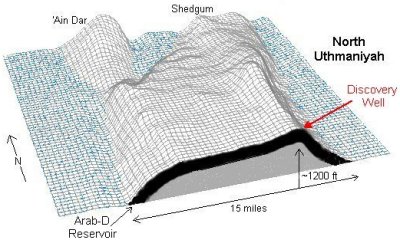 |
| Figure 2. top: location of discovery wells on 3-D rendering of Arab-D reservoir for Ghawar; bottom: cutaway rendering near 'Uthmaniyah discovery well |
Stacking the Deck
The "Mag Five" article provides some basic production data for each of the five wells, including production start, cumulative oil produced, and current flow. For these, one can calculate the average daily flow rate for each well. These data are summarized in the table below:

Two of the wells (Hawiyah-1 and Haradh-1) were presumed to be shutdown along with their respective fields during the price crash in the 1980s , so the years 1983-1990 were excluded from their calculated averages. And though the authors are loathe to type the words, the Uthmaniyah discovery well died a watery death some years ago.
Most of the production has come from the 'Ain Dar and Shedgum wells, due mostly to their high flow rates, but also because they have been flowing more or less continuously. They are both down from their lifetime average flow rates, however.
A couple of months after the "Mag Five" article came out, a story in Forbes appeared which used similar information in a story on Saudi oil:
"We go really slow and soft," says Al-Naim, the engineering chief. "Ghawar we treat as you would a young woman." Every Aramco well is fitted with an adjustable steel choke that restricts a standard 3-inch-diameter well bore down to a quarter-inch or less. Slowing the well reduces the amount of water that is produced alongside the oil, and a gentler flow protects the reservoir from damage.
Aramco's oldest operating well, Ain Dar 1, was drilled in 1948. This single well in the Ghawar complex has produced 152 million barrels from its original casing. The well's free-flow rate is now 8,000 barrels a day, but Aramco restricts it to 2,500. It insists that rumors of Ghawar's demise are premature. The field has given up some 45 billion of at least 100 billion barrels of original oil in place (only Aramco knows for sure, and it's not telling), yet still easily produces 5 million barrels a day; its overall water cut has declined in recent years to only 28%. Says Nasser, "If I needed more production I could go to Ghawar and boost it to 10 million barrels a day."
The suggestion here is that 'Ain Dar-1 could be producing more than its lifetime average but is instead being throttled back to 2500 or lower. The more outlandish claim -- that Ghawar could produce 10 million barrels on demand -- does make one question any numbers provided. For one thing, there is no way to provide that much water to pump into Ghawar, and thus the field pressure would quickly collapse.
The "Still Going Strong" article presents similar numbers but also tantalizes us with a graphic showing the production history for the wells. Unfortunately, it was routed through Saudi Aramco's data obfuscation department; their first act was providing running sums instead of showing actual rates, and the second was stacking the data to yield a completely meaningless summation of the five disparate wells. This graphic is reproduced below.
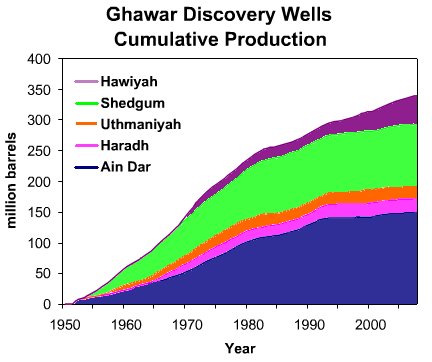 |
| Figure 3. Stacked presentation of cumulative production for five Ghawar discovery wells |
It is possible, though, to resurrect the more pertinent data from the above, more clearly delineating the production trend for each well:
| Figure 4. Unstacked presentation of cumulative production for five Ghawar discovery wells. Note: The above graphic is interactive. Click on each of the five well names to highlight an individual production history. Each will be discussed in detail subsequently. |
One could take this a step further by differentiating each curve to yield the instantaneous rate over time, but the noise level becomes too distracting to be helpful. Average daily flow rates can be obtained from periods of relatively steady production, however, as will be shown later. One thing that is apparent from the above graphic is that production for each of the Uthmaniyah, Hawiyah, and Haradh wells was rather minimal for a 20 year period. Possible explanations for the above production trends for each well will be covered in the next section.
Location Location
The "Mag Five" article shows approximate locations for each of the wells. More useful are old Saudi Aramco maps for Ghawar which show the well positions relative to other numbered wells, including Figure 3b from:
"Ghawar Oil Field, Saudi Arabia"
Bulletin of the American Association of Petroleum Geologists
Vol 43, No. 2 (February, 1959), pp 434-454
 | |
| Figure 5. Left: Discovery wells for Ghawar shown on Google Earth map. Right: Overlay of 1959 map section for north Ghawar on Google Earth. Large black dots are discovery wells, small dots are other 1959 wells. Move cursor over image to show actual locations of existing wells which correspond to those on 1959 map. | |
The well spacings on this map were overlayed on the actual spacings on the imagery in Google Earth. A combination of sufficient resolution on the map (in the vicinity of each discovery well) and the relatively sparse well placement in Ghawar permits an unequivocal identification of each of the five wells. A Google Earth KML file which includes the well locations and the Ghawar field boundaries can be found here.
For more information about (and examples of) using Google Earth to geo-reference maps, see the links below.
Note: Underlying satellite imagery in the figures for this work are copyright Google and DigitalGlobe.
In the next sections, I will look more closely at each of the discovery wells -- both literally and figuratively.
'Ain Dar-1
The 'Ain Dar discovery well, the first well drilled in Ghawar, is located in north central 'Ain Dar. After pinpointing the exact location of the well a shown earlier, one thing to do is take a close look to see if anything is or has been happening around the wellhead. New features of Google Earth makes this a simple task, as archival images (if they exist) can be browsed to look for changes. For the area around 'Ain Dar #1, images are available from 2003 and 2006, as shown below.
| Figure 6. Close up satellite image of 'Ain Dar discovery well from 2003. Mouseover reveals 2006 appearance. |
Note that there are pipelines running both north (to Gas Oil Separation Plant #1) and south (to GOSP #2). From the images, it appears that the south pipeline is the one currently in use. There are some small changes visible, including a plumbing replacement at the wellhead. It is not likely that any other substantial modification of this well has been done. By way of comparison, consider the image pair (shown below) for another 'Ain Dar well, located 4.5 km to the northeast of ANDR-1. This well was being re-drilled in 2006, and such efforts leave a pronounced footprint on the wellsite. Newer drilling procedures seem to require the staging of more equipment and facilities, thus requiring more physical area. Older wells which have not been redrilled retain the original footprint.
| Figure 7. Close up satellite image of another 'Ain Dar well obtained in 2003. Mouseover reveals 2006 re-drilling. |
Although not much can be discerned from looking at the well itself, more is learned by looking at the surrounding wells. The north-central part of 'Ain Dar was apparently an area of interest for Saudi Aramco in 2003-2005, with several new wells added to provide additional dry production for delivery to the existing Gas-Oil Separation Plants (GOSPs).
Three articles from Saudi Aramco give useful information (often unwittingly) on the placement of a Maximum Reservoir Contact (MRC) well in northern Ghawar: ANDR-524.
- Water Management in North 'Ain Dar, Saudi Arabia (SPE 93439
- Optimizing Maximum-Reservoir-Contact wells: Application to Saudi Arabian Reservoirs (IPTC 10395).
- Well Placement Optimization Using GIS (from 2005 ESRI International User Conference Proceedings
MRC wells typically have two or more laterals drilled horizontally from a single wellbore. Saudi Aramco had previously placed such wells in the low-permeability Shaybah field and more recently in the Haradh area of Ghawar (Haradh II increment). The ANDR-524 was the first MRC well targeting Ghawar's higher-quality rock in the north.
The goal was to tap into multiple reservoirs layers simultaneously with the capability of shutting off individual laterals as they became watered out. According to the above articles, this was an area that (in 2005 or so)
was seemingly on the front lines in 'Ain Dar for maximizing oil extraction from thinned oil layers before of the advancing water made it less accessible. The latter two articles included oil thickness plots which indicate the depletion state of the reservoir in the vicinity of the location of the new MRC well. In Water Under the Gas Cap in Ain Dar,
I showed how Google Earth could be used to geo-locate ANDR-524 and these oil layer thickness diagrams. After pinpointing the exact location of ANDR-1, as luck would have it, I realized that it lies within area covered by the oil thickness plot from the ESRI article.
Shown below is an interactive view of a 25 sq. km area near ANDR-1 obtained using Google Earth. Mouseover the image to show exact wellhead locations, and then click on image to show the oil layer thickess contours. The date of the image is May 2006.
| Figure 8. Section of Ghawar near 'Ain Dar discovery well. Mouseover show actual well locations visible in May 2006.Click on image to view oil thickness plot superimposed on the satellite imagery. Labeled contours correspond to the top of the Arab-D reservoir in feet below sea level, and red trace indicates boundary of gas cap located at the crest of 'Ain Dar. Click here to view the well area in Google Maps. |
The 2006 image above shows mostly weathered well sites along with two newer wells.
By comparing with the archival 2003 image, small changes were observed for seven wells similar to those noted for ANDR-1 above.
Wells drilled prior to 2003 were at 1 km spacing, and from looking at the well layout in the overlay (click on image), they would seem to be vertical wells.
New wells, including ANDR-524, are drilled horizontally with possible multilaterals.
Thus, the location of the wellhead is less determinant of what part of the field is being drained by it.
The laterals of ANDR-524 are targeting unswept oil to the east.
At the top of the overlay, there is an indication of a bi-lateral well with one arm going after oil near ANDR-1, although the location of the northern-most new wellhead is a few hundred meters distant. The other new well is probably targeting the thinning oil column to the east similar to ANDR-524.
There was no scale for the oil thickness map provided in the ESRI article, but it is similar in color scheme to oil-thickness diagrams published elsewhere by Saudi Aramco engineers. There are 7-8 distinct color bands in the full image. Assuming a 200 ft. full thickness, this would give ~30 feet per division. Based on this estimate, the Arab-D reservoir where penetrated by 'Ain Dar #1 is crudely estimated to have 50-80 feet of oil left. Unfortunately, it is not certain that this diagram accurately reflects the state of the reservoir just before ANDR-524 was drilled. However, the ESRI article describes the use of a software program with a specific purpose: assist in the placing of a new well by combining geophysical data and existing well placement data in a Geographic Informtion
System. The program seems to rely on current data and does not have predictive capability (e.g. simulating the depletion state some years in the future).
The task of planning a new well in a field with a high density of wells, complex geological features, multiple formation targets and advancing flood front or expanding gas cap is extremely challenging.
...
The existing well locations, flood front/oil column maps and reservoir structure information can now be used as an effective guide to place new well locations.
Finally, the state of the reservoir near ANDR-524 as suggested by the diagram is consistent with this description from the first of the three referenced articles:
The well is placed at the top of the target reservoir in a partially flooded area of the field and is planned to produce dry oil while the surrounding vertical wells are producing at water cuts in the range of 32-62%.
...
Following the successful operation of this MRC well, additional complex wells are planned to be drilled to further develop the field and keep water-cut at the current level of 42%.
ANDR-1 Production History
The collective Saudi Aramco articles provide the following data -- initial rate: 15,600 bpd; 2008 rate: 2100 bpd; cumulative: 152 million barrels; first water produced in 1999.
Looking at the cumulative production profile below, the well was not produced at the reportedly high initial rate for long. Production did ramp up about the time that powered water injection was implemented in the field (gas was injected before this to maintain pressure, followed by gravity-fed water injection).
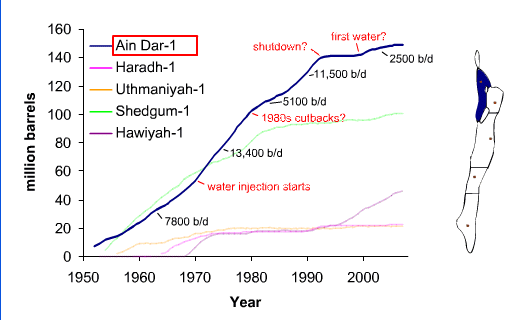
Figure 9. 'Ain Dar-1 cumulative production.
The production dropoff around 1980 is conceivably explained by the overall cut in North Ghawar production about that time, as seen by the combined 'Ain Dar/Shedgum production history (provided by Nansen Saleri, then of Saudi Aramco, in 2004) shown below. However, the nearly complete cessation of production in the early 1990s does not correlate with what was going on in the overall field.
A more likely explanation than the one provided in the articles is that water hit the well in the early 1990s, and then it was shut down until more wells in drier areas could be put in so as to lessen the load on the GOSPs which, as revealed by Saudi Aramco, were processing all the water they could handle. The well was flowing again by 1999, although the rate has been decreasing somewhat since.

Figure 10. 'Ain Dar/Shedgum daily oil production history
In summary, this well has had a remarkable, if somewhat erratic, production history. It clearly has its best days behind it, though, as the water level will keep rising until nothing but water flows. If it is not capped and redrilled as a horizontal, it will either be shutdown or throttled way back as newer horizontal wells drain the oil from its vicinity.
Haradh-1
The discovery well in Haradh was the second well to be drilled in Ghawar, and seemed to be quite productive initially (6,400 bbl/d). However, due to the distance to the existing production facilities at Abqaiq, HRDH-1 was not brought online until the early 1960s.
A few dilineation wells had been drilled by then, as seven wells appear on the 1959 Haradh map. The well count increased to 12 by 1971, and then to at least 65 over the next twenty years. Haradh was completely shut off for most of the 1980s, and it wasn't until the first of three redevelopment increments (Haradh-I) was completed in 1996 that Haradh contributed much to Ghawar's total flow. This first increment was first completed with vertical wells and water injectors, but the water flood proved to be very erratic and many wells quickly watered out. Haradh is hightly fractured, and even though vertical wells rarely cut through them, these fractures, in combination with Super-k intervals, created conduits by which water could prematurely flow from injectors to wells, bypassing the oil.
Super-k intervals are relatively thin sections of reservoir rock (as little as a few feet) which contribute disproportionally to the overall flow of the well. These are handy when flowing oil, but much less so when flowing water.
The vertical wells of Haradh-I were later supplemented with horizontal wells, and the plan for the Haradh-II increment called for all horizontal producers and injectors. 3-D seismic mapping of Haradh was performed to identify major fractures such that horizontal wells could be directed so as to avoid them. Problems still arose, however. During the drilling of several wells, lost circulation of drilling fluid was reported. Normally, drilling fluid (or mud) is pumped down to the drill head and returns to the surface carrying debris. If a fracture or Super-k interval is penetrated by the drilling, as much as 100% of the drilling fluid (or mud) does not get recirculated but instead gets pumped into the reservoir. This adds considerably to the time and expense of drilling the well, but also indicates a significant probability for early water breakthrough depending on where the loss is occuring and the distance from the water injectors. Somewhat after Haradh-II was brought online in 2003, a few MRC wells were added to the mix. The advantage of these was that individual laterals could be shut off if they started flowing water. This trend culminated in the decision to develop the final increment, Haradh-III, using only MRC producers.
The Haradh discovery well is located in the center of the "heel" and on the southern edge of what would become the Haradh-II increment, as shown in the figure below. The base image shows the locations of wells prior to the 1996 redevelopment. Mouseover reveals the locations of Haradh-II wells trajectories of the laterals. Mouseclick shows the locations of subsequent drilling in the area (caveat: the lower third of the image dates to 2004, whereas the upper two thirds dates to 2006). Note the added wells between HRDH-1 (discovery well) and the water injectors to the east. A
closeup look at HRDH-1 isn't particularly informative.
| Figure 11. Google Earth view for central Haradh showing locations of early wells. Mouseover shows Haradh-II development. Click to show additions visible in 2006. |
It is likely that HRDH-1 production was deemed inconsequential or perhaps counterproductive to the newer production plans, and this likely became more the case after Haradh-II was completed.
Any delineation between Haradh-II and Haradh-III oil is artificial, of course. The bottomhole pressure for HRDH-1 will be affected by downdip wells corresponding to both increments. Shown in the image below is a closer view of HRDH-1 relative to the newer wells. One of the Haradh-II wells, HRDH-489 the well closest to HRDH-1, experienced 100% circulation loss during drilling, but the later drilling of the MRC well HRDH-470 seemed to go more smoothly. As for Haradh_III, Saudi Aramco published some pressure measurements taken when the new injectors were completed (prior to production; see Figure 5 in this paper). The low pressure zone at the top of the figure corresponds to the area of the field encompassing wells HRDH-1, HRDH-13, and HRDH-28. A scale for the pressure gradations was not provided, unfortunately.
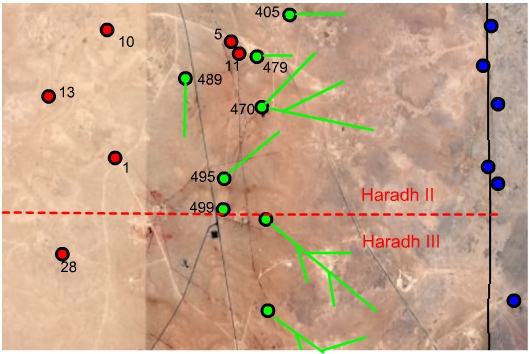 |
| Figure 12. Closeup Google Earth view of wells near HRDH-1 (Haradh discovery well). |
HRDH-1 Production History
As the plot below indicates, most of the cumulative production of HRDH-1 occured prior to the shutdown in the 1980s, despite the absence of water injection during those early years. Although the restarted production was boosted with acid stimulation up to 6700 bbl/d in 1990, this spurt only lasted a couple of years for reasons unreported. While it probably has the capability of flowing 2300 bbl/day as reported, this doesn't appear to have been the case over the last few years.

Figure 12. Haradh-1 cumulative production.
'Uthmaniyah-1
One close Google Earth look at the 'Uthmaniyah discovery well reveals the current status rather clearly; it became a non-performing asset sometime prior to 2006.
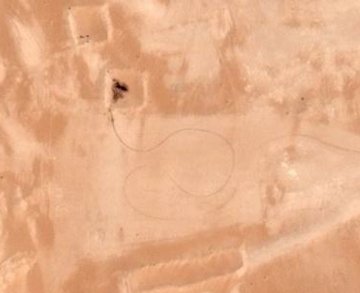 |
| Figure 13. The ghost well that is UTMN-1 |
As is the case with ANDR-1, there is some information as to the status of the reservoir in the vicinity of UTMN-1. Shown below is the area of the field near this well. Mouseover shows the oil layer thickness values reported in a figure from this paper but which can also be found here. This discovery well is clearly out to sea. The darker blue and green areas have 0-30 feet and > 120 feet of oil, respectively, remaining from over 200 feet initially. Click on the graphic to show the coutours for the top of the Arab-D reservoir. UTMN-1 is about half way up to the local crest for the east ridge, so it is not that surprising that is has watered out. It is amusing that the author avoids saying this outright, however.
| Figure 14. Google Earth view showing wells near UTMN-1. Red and green placemarks denote older and newer wells respectively, green diamonds denote drilling rigs, and blue placemarks denote water injectors. Mouseover shows recent oil thickness as described in text. Click to show elevation contours for Arab-D reservoir. |
UTMN-1 Production History
It is claimed that UTMN-1 produced at 11,300 bbl/day in its first year, and this is somewhat consistent with the reported cumulative production profile shown below.
However, the well seemed to be offline in the early 1960s, and then was again rather useless by 1975 as the waterflood had overrun it. Dates were not given for the reported attempt to shut off the water-producing sections of the well or its unreported abandonment. Perhaps a good well, but in an unfortunate location.
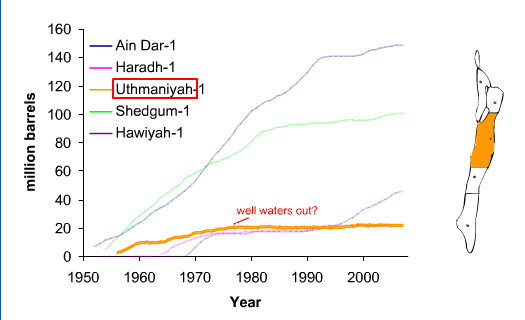
Figure 15. 'Uthmaniyah-1 cumulative production.
Shedgum-1
The Shedgum discovery well is located well updip of the water injectors on the east flank, but as Shedgum has been produced heavily for a long time, SDGM-1 is seeing higher water. Although the Saudi Aramco articles mention a recent project to drill a horizontal sidetrack of the well, the 2006 Google Earth/Maps view does not show recent evidence of this. There is a 2009 Digital Globe image of the area available, but GE hasn't incorporated the high resolution version; the low-res version shows no obvious changes around the well.
As was the case for ANDR-1, SDGM-1 is located in an area for which an oil thickness plot was published (IPTC 10395). As shown in the figure below (click on image), water clearly has reached the discovery well. It does seem to be in a better situation than ANDR-1, so it is interesting that it has been redrilled while the latter has not.
| Figure 16. Section of Ghawar near the Shedgum discovery well. Mouseover shows nearby oil (red) and gas (yellow) well locations. Click on image to show ~2005 oil thickness overlay. Click here to view the well area in Google Maps. |
SDGM-1 Production History
This well actually started its life with a higher production rate than ANDR-1, although it slowly declined (possibly along with the pressure in the field). The rejuvenation just prior to 1980 followed the acid treatment by a few years, and powered water injection was started before then as well.
Other maintenance didn't seem to have much of an effect, though. Any connection to the overall Shedgum production is also not obvious.
If the most recent resurgence is due to the horizontal sidetrack, this would suggest this was done early in the current decade. 3700 barrels per day seems a bit high though.
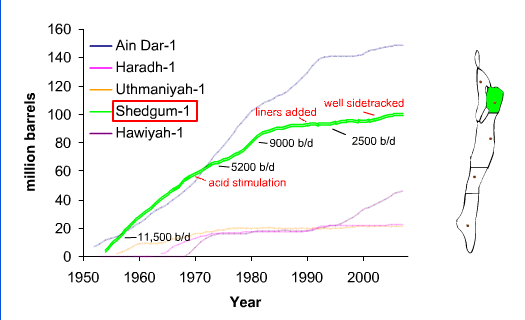
Figure 17. Shedgum-1 cumulative production.
Hawiyah-1
Of all of the Ghawar discovery wells, Hawiyah-1 seems best positioned for sustained production. It is located near the center of a section of Ghawar which should a lot of oil left. Very little data on the production history or current status of Hawiyah has been made available. However, the following was reported in 2005:
Pre-mature water injection breakthrough into the mid-field areas, through high permeability zones and fractures, caused some wells to die, leaving trapped oil behind and affecting reservoir sweep efficiency. The field is being developed by drilling highly deviated and true horizontal wells. Many of these wells died right after drilling or after a short period of production due to excessive water production from high flow intervals. Water isolation in such wells is both a challenge and expensive. The challenges include understanding the mechanism of water movement in the reservoir horizontally and vertically that might enable communication of the water from the lower zones to the upper zones through the reservoir after the water zone isolation in the well bore.
Similar to the case for Haradh, the Google Earth coverage of Hawiyah is a patchwork of 2004 and 2006 imagery. HWYH-1 is located in the north-center of Hawiyah, somewhat closer to the west flank than the east, in an area photographed in 2004. As shown below, four new wells located about 1 mile east of HWYH-1 were drilled between 2004 and 2006. These newer wells are midway between the injector lines, and it is curious that new wells are being drilled there at this point in the production history for Hawiyah. Of course, horizontal trajectories could be pointing in any direction from the wellheads with extents of several kilometers.
| Figure 18. Section of Ghawar near Hawiyah discovery well as photographed in 2004. Mouseover shows oil reveals 2006 imagery covering two-thirds of the view. Click here to view the well area in Google Maps. |
HWYH-1 Production History
It was reported that HWYH-1 initially produced 4,800 bpd and then 7600 bpd after acid stimulation in 1977. However, the shown profile below is more consistent with these values reversed.

Figure 19. Hawiyah-1 cumulative production.
Also, the average rate over the last decade was higher (5700 bbl/d) than is reported for the current (4600 bbl/d). The improvements to the water injection for Hawiyah during the 1990s perhaps accounts for most of the increased flow from HWYH-1.
Hawiyah-1: A Natural Horizontal Well
Given the lower porosity and permeability values for southern Ghawar in comparison to the north, both the Hawiyah and Haradh discovery wells had better flow rates than one would predict. As for HWYH-1, it turns out that it is no ordinary well, but rather a Super-k well.
In 2000, a study by Meyer et. al. on Super-k wells in the Hawiyah area of Ghawar was published:
Stratigraphic and Petrophysical Characteristics of Cored Arab-D "Super-k Intervals, Hawiyah Area, Ghawar Field, Saudi Arabia"
Franz O. Meyer, Rex C. Price, and Saleh M. Al Raimi
GeoArabia, Vol. 5, No. #3, 2000, pp. 355-384.This paper is not widely available, but several figures from it and discussion thereof are available in the doctoral dissertation of Joe Voelker (starting on page 111).
A Super-k well is defined as a well which intersects an interval (rock layer) having a productivity/injectivity of 500 barrels per day per foot. Based on flowmeter measurements, 88 wells (both producers and injectors) were identified as Super-k, and 8 of these wells were cored for further analysis. One of these, identified as HWYH-C in the paper, is unveiled here as Hawiyah-1. The Super-k behavior of this well is rather extreme:
Ninety-one percent of the oil produced (1,161.8 bf/d/ft) is from a section measuring 15 ft in HWYH-C. Super-k flow (820 bf/d/ft) is from the bottom six feet, and high flow (342 bf/d/ft) also occurs from the top nine feet.
From these numbers, it would seem that we have some actual flow measurements that we can compare with those reported in the "Mag Five" articles. Unfortunately, the numbers from the Meyer paper don't quite add up. Consider:
1,161.8 bbl/day/ft times 15 ft gives 17,430 bbl/day
However, if we compute the flow from the six and nine foot sections separately (and then sum), we get:
820 bbl/day/ft times 6 ft plus 342 bbl/day/ft times 9 ft = 7998 bbl/day
Either the average rate of 1,161.8 bbl/day/ft from the 15 ft. section is correct, or the rates for the six and nine foot sections are -- but not both. Suspiciously, 820 plus 342 roughly equals 1161.8, so perhaps (astonishingly) the authors just added the two averages to get a new one.
If is the case, then the total flow for the 15 ft section would really be 7998 b/d, or an average of 533 b/d/ft across the entire 15 ft. section. This is consistent with the reported production history of HWYH-1; dividing by .91 (the fraction of oil from the 15 ft. section) gives 8789 bbl/day for the entire well. In any case, this well is capable of higher production than is currently the case, and as of the 2000 publication date for the paper, was not producing significant water.
It is worth reflecting on this amazing phenomenon; a vertical well is drilled through ~200 feet of reservoir, but 56% of the oil flows out of a five foot slab and another 35% flows from an adjacent nine feet. But the permeabilities of the rock these intervals are not high enough to support these flows, so something else is going on.
Core plug analysis throughout the 15-foot thick flow zone indicates that good but not exceptionally high permeability (average 540 md) occurs in the predominantly grainstone interval. Furthermore, the average permeability is higher in the high-flow zone (612 md) than it is in the super-k flow interval (344 md). Fractures readily explain this discrepancy because they override the matrix permeability at the base of the super-k interval. Supporting evidence includes observed fractures in the recovered core, an underlying enterval of core rubble within the basal part of the super-k flow interval, and two feet of missing core immediately beneath it.
What does this flow look like? In his dissertation, Joe Voelker found that a linear flow model is better supported by the data than a radial flow model. Thus, it is perhaps best to think of a Super-k well as a natural horizontal well, where the Super-k interval acts as the (perforated) horizontal well bore. This is very adventageous when this oil flows into this interval (or fracture) from the immediate surroundings, but it is rather disasterous when water flows in. If the latter occurs, isolating the interval (blocking the flow) can dramatically lower the water cut, but the result is a much reduced oil rate. In many such cases, Saudi Aramco has chosen to produce the Super-k flow and deal with the extra water as the lesser of two evils. The Hawiyah discovery well seems to have avoided this fate so far, as the Super-k interval is in the upper layers of the reservoir -- although a fracture could eventually produce water from lower layers as the flood front advances.
Conclusion
A closer look at the continuing saga of the five Ghawar discovery wells provides an interesting glimpse at the history and current state of the field.
Ghawar is truly an outlier, even amongst supergiant fields. Its full story, with warts and all, is much more interesting than what seems to squeeze out of the Saudi Aramco PR department. But even a field as unique as Ghawar has a finite supply of oil, and most of the original wells are reaching the limit of their usefulness. Perhaps not coincidentally, Ghawar might be getting a respite. Saudi oil minister Al-Naimi has indicated that Ghawar output will be cut back as Khurais is brought online in a few weeks.
Credits
- http://www.saudiaramco.com. Click Newsroom/Publications/Dimensions
- "Ghawar Oil Field, Saudi Arabia", Bulletin of the American Association of Petroleum Geologists, Vol 43, No. 2 (February, 1959), pp 434-454
- Water Management in North 'Ain Dar, Saudi Arabia (SPE 93439)
- (Optimizing Maximum-Reservoir-Contact wells: Application to Saudi Arabian Reservoirs (IPTC 10395))
- Well Placement Optimization Using GIS (2005 ESRI International User Conference Proceedings)
- Fifty-Year Crude Oil Supply Scenarios: Saudi Aramco’s Perspective
- First Lateral-Flow-Controlled Maximum Reservoir Contact (MRC) Well in Saudi Arabia: Drilling & Completion: Challenges & Achievements: Case Study (SPE 87959)
- A Probability Approach to Development of a Large Carbonate Reservoir with Natural Fractures and Stratiform Super-Permeabilities (SPE 81433)
Maximum Reservoir Contact Wells: A new Generation of Wells for Developing Tight Reservoir Facies (Salam P. Salamy, SPE Distinguished Lecturer Series Program
2004 -2005)
Reservoir Monitoring with Permanent Borehole Seismic Sensors- Inflatable Enables Successful Water Shutoff in High Angle Wellbores in Ghawar Field
- A Reservoir Characterization of Arab-D Super-K (Joe Voelker Thesis, 2004)
- Stratigraphic and Petrophysical Characteristics of Cored Arab-D "Super-k Intervals, Hawiyah Area, Ghawar Field, Saudi Arabia" Franz O. Meyer, Rex C. Price, and Saleh M. Al Raimi GeoArabia, Vol. 5, No. #3, 2000, pp. 355-384.


1 comment:
It is worth reflecting on this incredible phenomenon; a vertical properly is drilled
Post a Comment